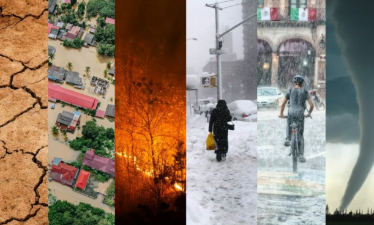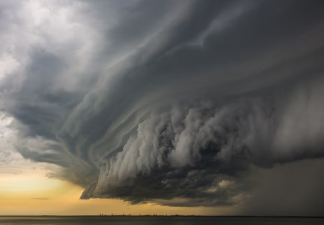In recent years, global extreme weather events have increased significantly, including torrential rain and flooding, high temperatures and droughts, and severe typhoons. This phenomenon is driven by the combined effects of a variety of natural and human factors.
Global warming: Destabilizing the climate system's "stabilizers"
Since the Industrial Revolution, human emissions of carbon dioxide have caused atmospheric concentrations to soar from 280 ppm to 420 ppm, effectively wrapping the Earth in an increasingly thick blanket. This greenhouse effect has fundamentally altered the underlying logic of the climate system:
- Extreme heat becomes the new normal
The 2023 El Niño event, combined with the impact of human activities, will cause the global average temperature to rise by 1.55°C compared to pre-industrial levels, with 2024 becoming the "hottest year" ever. High temperatures not only directly threaten human health (such as rising mortality rates from heatstroke), but also trigger chain reactions: melting Arctic sea ice weakens the polar vortex, leading to alternating cold and heat waves; marine heat waves bleach coral reefs and disrupt marine ecosystems.
- Disruptions in the water cycle exacerbate rapid shifts between drought and flood
For every 1°C increase in atmospheric temperature, the water vapor carrying capacity increases by 7%, meaning more intense rainstorms and longer-lasting droughts. In 2024, southern my country experienced historic downpours, with localized rainfall reaching 1,000 mm in southern Anhui. Meanwhile, precipitation in the Huanghuai region in northern China decreased by 45.6% during the same period, creating a stark contrast between floods in the south and droughts in the north. This "drought-flood duality" unfolded globally: rare torrential rains in the Sahara Desert triggered floods, while the southwestern United States was mired in a once-in-a-century drought.
- Climate tipping points are accelerating
The Greenland ice sheet is losing 300 billion tons of ice annually. If it completely melts, it would cause global sea levels to rise by 7 meters. Amazon deforestation has exceeded 17%, potentially triggering a "rainforest-to-grassland" ecological transition. Crossing these tipping points could trigger irreversible climate disasters.
Climate System Disruption: Nature's "Butterfly Effect" of Retaliation
When the "gears" of the climate system begin to misalign, seemingly unrelated events can trigger a chain reaction:
El Niño and La Niña Events
- El Niño events: Abnormally high and sustained sea temperatures in the tropical oceans of the eastern and central equatorial Pacific alter atmospheric circulation patterns, leading to global climate anomalies and increasing the intensity and frequency of extreme weather events. For example, in 2024, the year following the impact of El Niño, record-breaking or devastating extreme weather events such as heavy rain and high temperatures could occur in many parts of the world.
- La Niña events: Abnormally low sea temperatures in the central and eastern equatorial Pacific also impact the global climate. Alternating with El Niño events, they exacerbate climate instability and increase the frequency of extreme weather events.
Humanity's excessive demands on nature are undermining the Earth's ability to self-regulate:
- Deforestation weakens ecological barriers.
Uncontrolled logging in Kedah, Malaysia, has transformed rainforests that once conserved water resources into "concrete forests," triggering flash floods when heavy rains occur. Globally, 10 million hectares of forest are lost annually, equivalent to the loss of two football fields every minute. Without the regulatory power of the "lungs of the Earth," the probability of extreme weather events increases by 30%.
- Urbanization creates a disaster amplifier.
Due to excessive groundwater extraction, Jakarta's land is sinking by 10 centimeters annually, with northern coastal areas experiencing as much as 25 centimeters, significantly reducing the city's flood control capacity. With 55% of the world's population living in cities, the combination of high population density and fragile infrastructure exponentially increases disaster losses. Global natural disaster losses are expected to reach $280 billion in 2023, with 70% concentrated in cities.
- Ocean pollution alters the climate engine.
Oceans absorb 90% of greenhouse gases, yet they are becoming "sick" due to plastic pollution and overfishing. By 2024, the Pacific "garbage vortex" had expanded to three times the size of France, disrupting the ocean's ability to regulate heat. This disruption is now taking its toll on humanity: ocean acidification is reducing shellfish production, and the disappearance of coral reefs is depriving coastal areas of their natural breakwaters.






